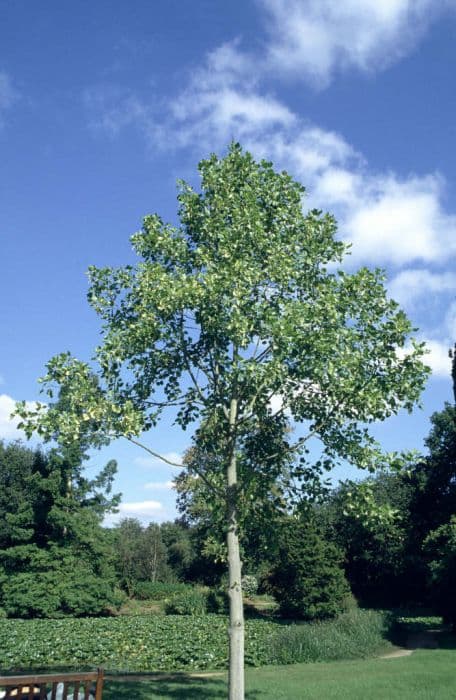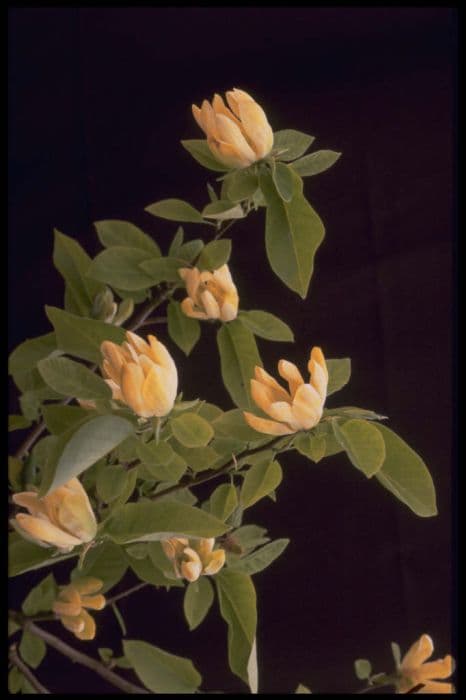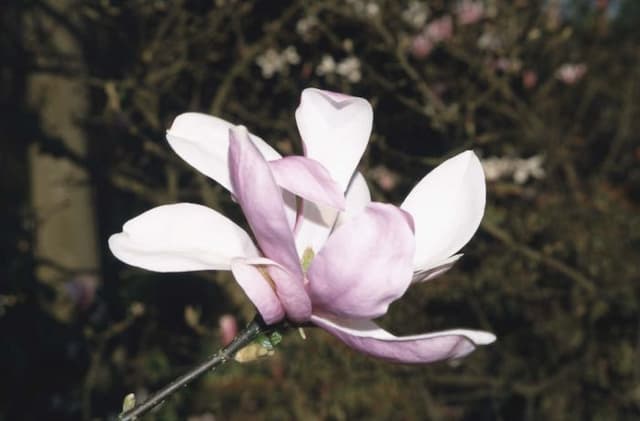Tulip tree Liriodendron tulipifera 'Snow Bird' (v)

ABOUT
The 'Snow Bird' tulip tree is recognized for its distinctive foliage and flowers. The leaves are shaped like those of classic tulip flowers, with four lobes and a unique notch at the tip. They lend an attractive, somewhat angular profile to the tree's appearance. In the growing season, the leaves are bright green, providing a lush, vibrant backdrop. As for the flowers from which it derives its common name, the tulip tree, they are large and showy with a cup-like form. The blossoms have six petals and are usually a contrasting mix of colors. The outer petals are greenish-yellow with a splash of orange at the base, while the inner petals are typically white, which is particularly prominent in the 'Snow Bird' variety. Thanks to these striking blooms, the tree has a captivating, ornamental quality when the flowers are in full display. The tree's bark adds another layer of visual interest. It is grey-brown and furrowed, providing texture to the trunk and branches that stands out notably in the winter months. 'Snow Bird' is a variation of the tulip tree with specific characteristics that may include variations in the coloration of flowers and leaves, but the precise nature of these may vary from one individual 'Snow Bird' tree to another. Overall, it maintains a stately and elegant appearance with its unique foliage and stunning floral display.
About this plant
 Names
NamesFamily
Magnoliaceae
Synonyms
Tuliptree, Tulip Poplar, Yellow Poplar, Whitewood
Common names
Liriodendron tulipifera 'Snowbird'
 Toxicity
ToxicityTo humans
The Liriodendron tulipifera, commonly known as the Tulip Tree, is not generally considered toxic to humans. There are no significant reports of human poisoning from ingesting parts of the Tulip Tree.
To pets
Similarly, the Tulip Tree is not known to be toxic to pets. There are no well-documented cases of pet poisoning from ingesting the leaves, flowers, or any other parts of the Tulip Tree. However, as with any non-food plant, consumption in large quantities may cause mild stomach upset in some animals.
 Characteristics
CharacteristicsLife cycle
Perennials
Foliage type
Deciduous
Color of leaves
Green
Flower color
Yellow
Height
70 feet (21 meters)
Spread
40 feet (12 meters)
Plant type
Tree
Hardiness zones
4
Native area
Eastern North America
Benefits
 General Benefits
General Benefits- Aesthetic Appeal: The 'Snow Bird' tulip tree offers striking white-edged variegated foliage and beautiful tulip-shaped flowers that enhance any landscape.
- Shade Provider: With its large, broad leaves, it creates substantial shade, making it an ideal choice for parks and large gardens.
- Biodiversity Support: Provides food and habitat for various wildlife, including birds and beneficial insects.
- Seasonal Interest: Exhibits vibrant autumn colors, adding seasonal variety to your garden display.
- Drought Tolerance: Once established, it is relatively drought-tolerant, requiring minimal maintenance in terms of watering.
- Fast Growth: Has a relatively quick growth rate, which allows for a swift impact on landscaping.
- Cultural Significance: The tulip tree is the state tree of Indiana, Kentucky, and Tennessee, making it an important cultural symbol.
 Medical Properties
Medical PropertiesThis plant is not used for medical purposes.
 Air-purifying Qualities
Air-purifying QualitiesThis plant is not specifically known for air purifying qualities.
 Other Uses
Other Uses- Carving Material: The wood of the tulip tree's 'Snow Bird' variant is soft and even-grained, making it suitable for amateur carving and whittling projects.
- Beekeeping: Tulip trees are a good nectar source for bees, and thus can be planted by beekeepers to enhance honey production.
- Canoe Construction: Traditional Native Americans used the trunks of tulip trees to craft dugout canoes due to its large size and workable wood.
- Windbreaks: This variety can be used in rural areas to create windbreaks that protect smaller plants and reduce soil erosion.
- Tulip Tree Syrup: Similar to maple syrup, sap from the tulip tree can be boiled down to create a sweet syrup, although it is less common.
- Dye Production: The bark of the tulip tree can be used as a source of dyes for textiles, yielding various shades depending on the mordant used.
- Soundboard Material: The wood is sometimes used in musical instruments as soundboard material, particularly for organs and harpsichords due to its acoustic properties.
- Educational Tool: The unique leaf shape and flower of the tulip tree make it an interesting subject for educational programs about plant identification and biodiversity.
- Natural Play Structures: Large fallen branches can be repurposed into creative play structures in gardens or natural playgrounds.
- Artistic Inspiration: The distinct flowers and stately form of the tulip tree often inspire artists and photographers who capture its beauty in various mediums.
Interesting Facts
 Feng Shui
Feng ShuiThe Tuliptree is not used in Feng Shui practice.
 Zodiac Sign Compitability
Zodiac Sign CompitabilityThe Tuliptree is not used in astrology practice.
 Plant Symbolism
Plant Symbolism- Beauty: The unique flower shape and coloration of the tulip tree are often associated with beauty and grace.
- Majesty: The tulip tree is known for its tall stature and impressive presence in the landscape, symbolizing majesty and grandeur.
- Fertility: As a tree that produces abundant flowers, the tulip tree can symbolize fertility and abundance.
- Healing: In some traditions, parts of the tulip tree have been used medicinally, which relates to its symbolism of healing and health.
- Resilience: Able to grow in a variety of conditions, the tulip tree is often seen as a symbol of resilience and adaptability.
 Water
WaterThe Tulip Tree should be watered deeply once a week, providing about 2 inches of water each time. Adjust the frequency to account for rainfall, ensuring the soil remains moist but not waterlogged. During hot, dry periods, increase watering to twice a week. Young trees particularly need consistent moisture to establish their root systems. It’s best to water early in the morning or late in the afternoon to reduce evaporation.
 Light
LightThe Tulip Tree thrives best in full sun, which means it requires at least 6 hours of direct sunlight each day. It can tolerate partial shade, but for optimal growth and health, choose a location where it won't be overshadowed by taller structures or trees.
 Temperature
TemperatureThe Tulip Tree can tolerate a range of temperatures, but it grows best when the temperature is between 60°F and 80°F. It can survive minimum temperatures down to around -20°F. Avoid exposing young saplings to frigid winds or frost, as this can damage or stunt their growth.
 Pruning
PruningPrune the Tulip Tree to maintain its shape and remove any dead or diseased branches. The best time to prune is in late fall or early winter when the tree is dormant. Light pruning can be done in any season except for late winter to early spring when the sap is running.
 Cleaning
CleaningAs needed
 Soil
SoilThe Tulip Tree 'Snow Bird' requires well-drained, fertile soil with a pH range of 5.0 to 7.5. A mix of loam, compost, and a small amount of sand is ideal to provide the necessary nutrients and drainage.
 Repotting
RepottingTulip Trees are large and typically planted outdoors; repotting is not a common practice. If in containers, young trees may need repotting every 2-3 years to accommodate root growth.
 Humidity & Misting
Humidity & MistingTulip Tree 'Snow Bird' prefers average outdoor humidity levels; too high or too low humidity is usually not a concern for this outdoor plant.
 Suitable locations
Suitable locationsIndoor
Not suited for indoor growth; too large.
Outdoor
Plant in full sun, moist, well-drained soil, and space for large growth.
Hardiness zone
4-9 USDA
 Life cycle
Life cycleThe 'Snowbird' Tulip Tree (Liriodendron tulipifera 'Snow Bird') begins its life as a seed, usually after being dispersed from a mature tree's fruits in the fall. After overwintering, the seed germinates in spring if conditions are suitable, requiring warmth and moist soil. The seedling emerges and, given enough light and nutrients, will grow rapidly, developing a straight trunk and characteristic four-lobed leaves. As the sapling matures into an adult tree, it develops its unique tulip-shaped flowers that are predominantly white, blooming in late spring to early summer. Following pollination by insects, the tree produces cone-like aggregate fruit, which contains winged seeds that are dispersed by the wind. The 'Snowbird' Tulip Tree can live for many decades, even centuries, and will continue to reproduce annually, completing its life cycle.
 Propogation
PropogationPropogation time
Spring-Early Summer
The tulip tree 'Snow Bird' variant is usually propagated through softwood cuttings. This method is often performed during the late spring or early summer when the new growth is still soft and green. The cutting, which should be about 6 to 8 inches (15 to 20 centimeters) long, is taken from a healthy branch and the lower leaves are removed to expose a few nodes where roots will develop. The cut end is then dipped in rooting hormone to encourage root growth and planted in a well-draining soil mix. To maintain humidity, which is crucial for root development, the cutting can be covered with a plastic bag or placed in a propagator. It should be kept in indirect light until roots have established, after which it can be gradually acclimated to more direct light and eventually replanted outdoors.







![Magnolia [Black Tulip]](/_next/image?url=https%3A%2F%2Fplants-admin.emdemapps.com%2Fimages%2Fplants%2F%2Fimages%2F604b590290fc7.png&w=640&q=75)

